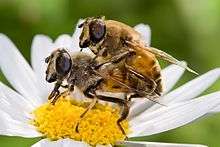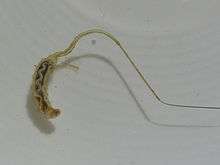Eristalis tenax
| Eristalis tenax | |
|---|---|
 | |
| Eristalis tenax. Male | |
_female.jpg) | |
| Female | |
| Scientific classification | |
| Kingdom: | Animalia |
| Phylum: | Arthropoda |
| Class: | Insecta |
| Order: | Diptera |
| Family: | Syrphidae |
| Genus: | Eristalis |
| Subgenus: | Eoseristalis |
| Species: | E. tenax |
| Binomial name | |
| Eristalis tenax | |
| Synonyms | |
Eristalis tenax is a hoverfly, also known as the drone fly (or "dronefly").
Distribution
Eristalis tenax is common, migratory and cosmopolitan, the most widely distributed syrphid species in the world, and is known from all regions except the Antarctic. It has been introduced into North America and is widely established. It can be found in gardens and fields all over both Europe[2] and Australia,[3] but have also been found all the way up in the Himalayas.[4]
Description
Eristalis tenax is a large (wingspan 15mm), stocky, bee mimic. Eyes are marbled in black. Males have hovering displays.
Technical Description
External images For terms see Morphology of Diptera Wing length 9·75–13 mm. Stout appearance. Femur 3 thick, hanging down while hovering. Antennomere 3 brownish-black. Tergite 2 with yellow, orange or reddish side-markings. Arista bare. Eyes brown-haired, with two distinct bands of dense and darker hair. Male eyes clearly holoptic. All tarsi black.[5][6][7][8] The male genitalia are figured by Hippa et al. (2001)[9] The larva is figured by Hartley (1961)[10] and in colour by Rotheray (1993).[11]
Biology

Larvae are saprophagous. The larva of E. tenax is a rat-tailed maggot. It lives in drainage ditches, pools around manure piles, sewage, and similar places containing water badly polluted with organic matter.[12] The larva likely feeds on the abundant bacteria living in these places.
When fully grown, the larva creeps out into drier habitats and seeks a suitable place to pupate. In doing so it sometimes enters buildings, especially barns and basements on farms. The pupa is 10–12 mm long, grey-brown, oval, and retains the long tail; it looks like a tiny mouse.

The adult fly that emerges from the pupa is harmless. It looks somewhat like a drone honey bee, and likely gains some degree of protection from this resemblance to a stinging insect. The adults are called drone flies because of this resemblance. In its natural habitat, E. tenax is more of a curiosity than a problem. Like other hover flies, they are common visitors to flowers,[13] especially in late summer and autumn, and can be significant pollinators. They mainly feed on flowers of carrot and fennel.
Infection
There have occasionally been documented cases of human intestinal myiasis of the rat-tailed maggot (larva of Eristalis tenax). Infection can be asymptomatic (no symptoms) or can manifest as symptoms ranging from abdominal pain, nausea and vomiting, to anal pruritus. Infection can be caused by ingestion of contaminated food or water but doubts have been expressed that accidentally ingested fly larvae could survive in the gastrointestinal tract. Zumpt proposed an alternative called "rectal myiasis". Flies, attracted to feces, may deposit their eggs or larvae near or into the anus, and the larvae then penetrate further into the rectum. They can survive feeding on feces at this site, as long as the breathing tube reaches towards the anus.[12][14]
Territoriality
The males of E. tenax can be heavily territorial in the summer, guarding territories including flowerbeds or bushes for a chance to mate. The males hover still in the air and dart after intruders to chase them out of the territory.[15]
References
- ↑ Stubbs, Alan E.; Falk, Steven J. (1983). British Hoverflies: An Illustrated Identification Guide. British Entomological & Natural History Society. p. 253, xvpp. ISBN 0-9502891-4-0.
- ↑ Francuski, Ljubinka; Djurakic, Marko; Ludoški, Jasmina; Milankov, Vesna (2013-08-01). "Landscape genetics and spatial pattern of phenotypic variation of Eristalis tenax across Europe". Journal of Zoological Systematics and Evolutionary Research. 51 (3): 227–238. doi:10.1111/jzs.12017. ISSN 1439-0469.
- ↑ Hull, Frank M. (1937). A Check List of the Syrphidae of Oceania. Honolulu, Hawaii: Bernice P. Bishop Museum.
- ↑ Shah1;Jan2;Ahmad Wachkoo3, Ghulam Mustafa1;Ulfat2;Aijaz3 (2014). "A CHECKLIST OF HOVERFLIES (DIPTERA/ SYRPHIDAE) IN THE WESTERN HIMALAYA, INDIA" (PDF). Acta Zoologica Academiae Scientiarum Hungaricae. 60 (4): 283–305.
- ↑ Van Veen, M. (2004) Hoverflies of Northwest Europe: identification keys to the Syrphidae. 256pp. KNNV Publishing, Utrecht.addendum
- ↑ Van der Goot,V.S. (1981) De zweefvliegen van Noordwest - Europa en Europees Rusland, in het bijzonder van de Benelux. KNNV, Uitgave no.32: 275pp. Amsterdam.
- ↑ Bei-Bienko, G.Y. & Steyskal, G.C. (1988) Keys to the Insects of the European Part of the USSR, Volume V: Diptera and Siphonaptera, Part I. Amerind Publishing Co., New Delhi. ISBN 81-205-0080-6.
- ↑ Coe, R.L. (1953) Diptera: Syrphidae. Handbks.ident.Br.insects, 10(1): 1-98. R.ent.Soc.London. pdf
- ↑ Hippa, H., Nielsen, T.R. & van Steenis, J. (2001) The west Palaearctic species of the genus Eristalis Latreille (Diptera, Surphidae). Norw.J.Entomol., 48: 289-327.
- ↑ Hartley, J.C. (1961) A taxonomic account of the larvae of some British Syrphidae. Proc.zool.Soc.Lond.,136: 505-573.
- ↑ Rotheray G., 1993 Colour Guide to Hoverfly Larvae Diptera, Syrphidae in Britain and Europe Dipterists Forum pdf
- 1 2 Aguilera, A; Cid, A; Regueiro, BJ; Prieto, JM; Noya, M (1999). "Intestinal Myiasis Caused by Eristalis tenax". Journal of Clinical Microbiology. 37 (9): 3082. PMC 85471. PMID 10475752.
- ↑ Van Der Kooi, C. J.; Pen, I.; Staal, M.; Stavenga, D. G.; Elzenga, J. T. M. (2015). "Competition for pollinators and intra-communal spectral dissimilarity of flowers" (PDF). Plant Biology. 18: 56. doi:10.1111/plb.12328.
- ↑ Phillip B. Whish-Wilson (2000). "A possible case of intestinal myiasis due to Eristalis tenax". Medical Journal of Australia. Retrieved January 13, 2008.
- ↑ Fitzpatrick, Sheila M. (1981). Territorial aggression among males of three Syrphid species. The University of British Columbia.
External links
| Wikispecies has information related to Eristalis tenax |
| Wikimedia Commons has media related to Eristalis tenax. |
- External images
- Drone fly on the University of Florida / Institute of Food and Agricultural Sciences Featured Creatures website